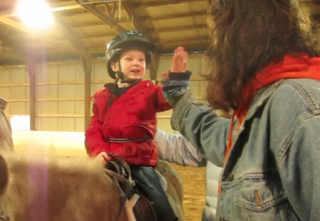Hippotherapy - Boy + Service Dog + Tolerant Horse = Good Times

Today’s outing with Bubbles involved a new species of animal — for Sam and for Bubbles! We decided to try an evaluative session on horseback to see if Sam could benefit from equine therapy. Many researchers have noted that often, when autistic children are first introduced to hippotherapy, the new environment may prompt crying, screaming, tantrums, and avoidance behaviors such as flopping down and becoming limp. For our Sam, there's also risk of flight.
Sam and his mother were first to arrive at the stables, since I was delayed by rain and traffic. By the time I arrived with my daughter Sophie in tow--Sam's favorite girl--Mom was ready to leave. Heavy rain and deep puddles added to the daunting prospect of luring the weeping boy out of his car seat and back into the stable, but we persevered. Equine therapy literature also notes that negative behaviors almost always stop as soon as the child is on the horse and the horse begins to move. And we still had to work Bubbles into the fray. Her job would be to get Sam to and from this activity and then to sit and do nothing, no small task for an athletic dog new to this world and these hooved, snorting, swishy-tailed animals.
As Sam's experience on horseback increases, Bubbles will learn more and more about the art of doing nothing--and how to leave sawdust-flavored horse dung alone! Researchers have done studies that show equine therapy offers autistic children a greater sense of themselves, their bodies, and contact and interaction with the world around them, and our day certainly went a long way towards supporting this research. Sam's wide grins, cooperative behavior, infectious giggles, awareness of sounds and smells and sights along with his relaxed posture both during and after his ride were evidence enough for us. We'll be back for more!




